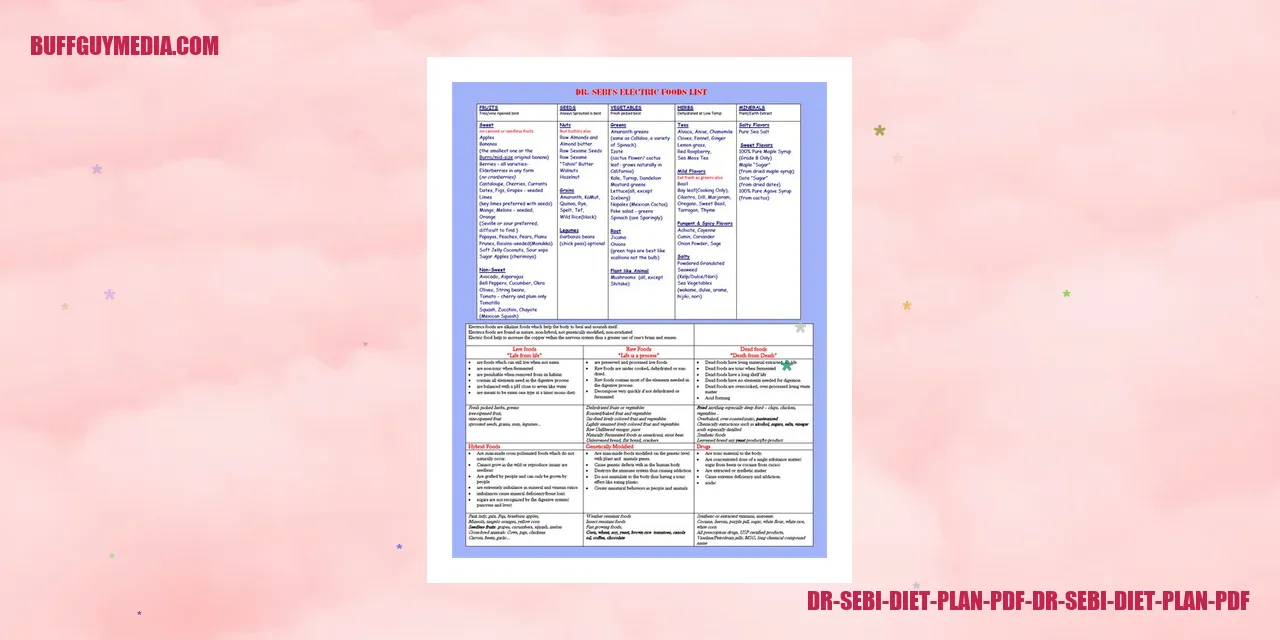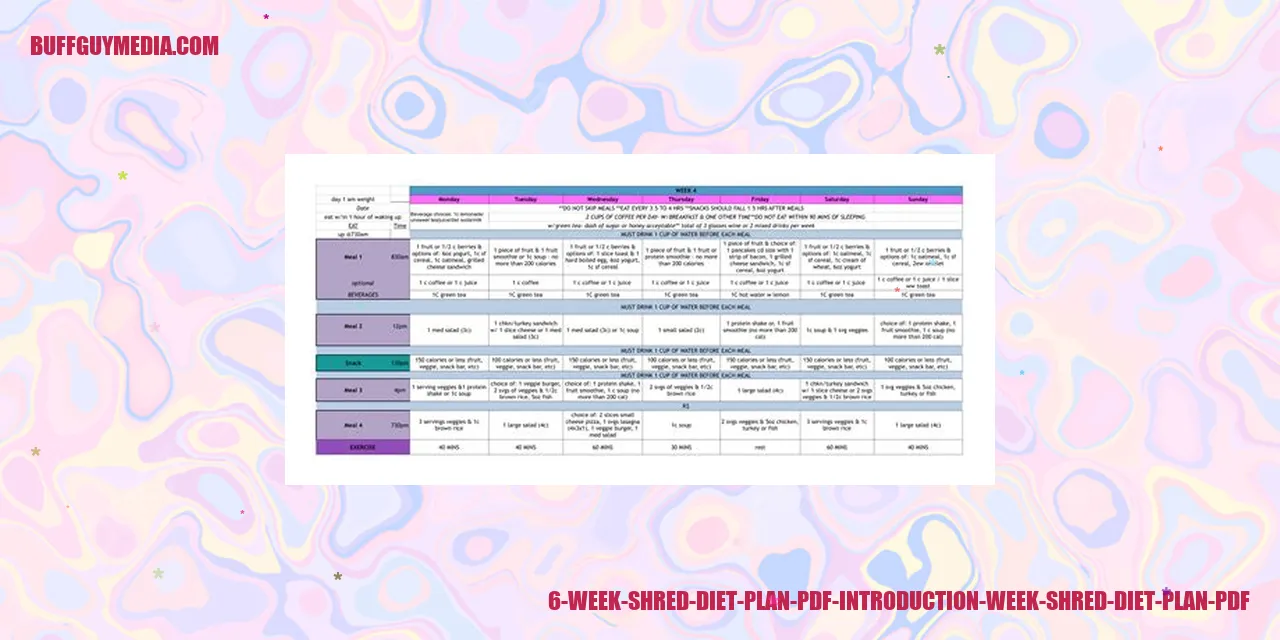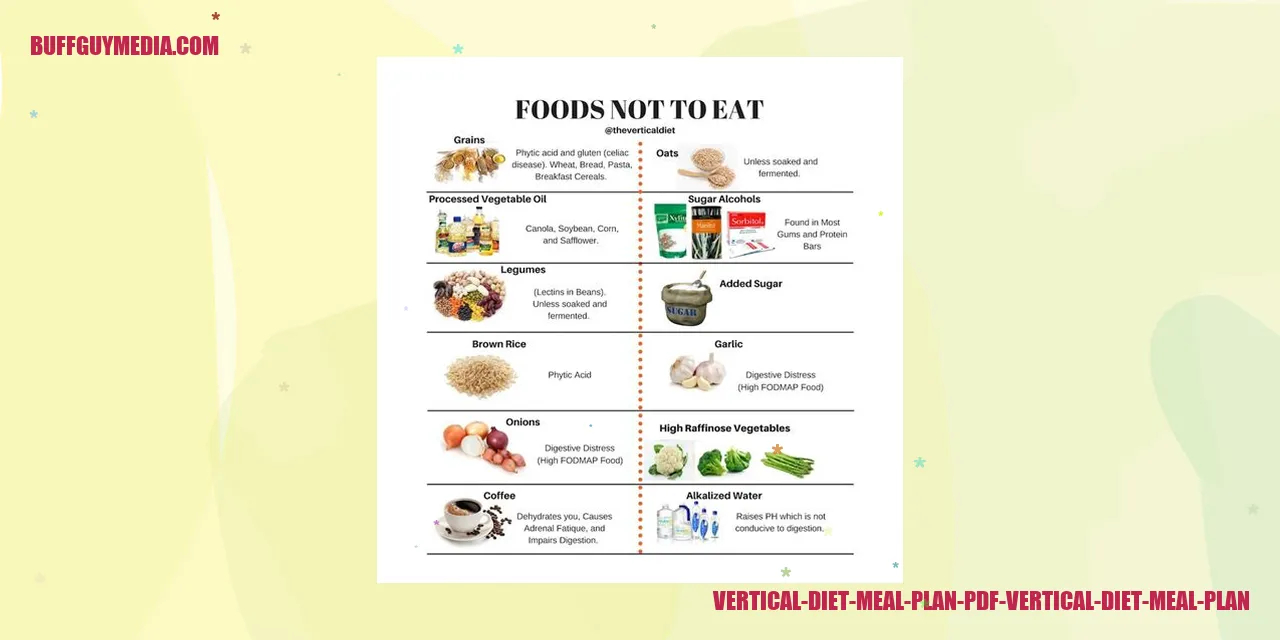Clickbait Heading
Breaking Down the metabolic confusion Diet Plan
Understanding the metabolic confusion Diet Plan
The Metabolic Confusion diet plan is a revolutionary approach to weight loss that revolves around the idea of constantly changing your eating patterns to boost your metabolism. By strategically altering the composition of your macronutrients and calorie intake, this diet plan aims to confuse your body’s metabolism, preventing it from getting accustomed to a specific routine.
Unlike traditional diets that follow a consistent pattern, the Metabolic Confusion Diet Plan encourages you to cycle between different types of meals. This includes alternating between high and low carbohydrate days and varying the number of calories you consume. By continuously switching things up, your metabolism stays active, which helps prevent weight loss plateaus and ensures consistent fat burning results.
How does the Metabolic Confusion Diet Plan work?
The Metabolic Confusion Diet Plan works by constantly challenging your metabolism through the manipulation of macronutrients and calorie intake. By consistently changing your fuel sources and caloric quantities, your body is forced to adapt and adjust, resulting in an increased metabolic rate and enhanced fat burning.
When you stick to a consistent dietary routine, your body eventually adjusts its metabolism to conserve energy and decrease fat burning. However, the Metabolic Confusion Diet Plan disrupts this adaptation by introducing regular changes. This ensures that your body continues to effectively burn fat and achieve weight loss goals.
Benefits of Embracing the Metabolic Confusion Diet Plan
There are several benefits associated with adopting the Metabolic Confusion Diet Plan, making it an attractive option for individuals looking to shed excess weight and improve their metabolic health. Here are some key advantages of following this diet plan:
[[READMORE]]
1. Increased Metabolism: By consistently modifying macronutrients and caloric intake, the diet plan helps to rev up your metabolism, resulting in more efficient calorie burning and sustained weight loss.
2. Overcoming Weight Loss Plateaus: Many people encounter frustrating weight loss plateaus during their journey. The Metabolic Confusion Diet Plan provides a solution by constantly challenging your metabolism, allowing you to break through these plateaus and continue making progress.
3. Improved Adherence: The diet plan offers flexibility in terms of food choices, enabling you to enjoy a wide variety of meals while still achieving your weight loss goals. This flexibility enhances adherence to the diet plan, making it more sustainable in the long run.
4. Preserves Lean Muscle Mass: Unlike restrictive diets that often lead to muscle loss, the Metabolic Confusion Diet Plan focuses on varying macronutrients. By doing so, it promotes the preservation of lean muscle mass while facilitating fat loss.
A Glimpse into a Sample Meal Plan for the Metabolic Confusion Diet
Here’s a sample meal plan to give you an idea of how you can structure your meals when following the Metabolic Confusion Diet Plan:
Day 1:
– Breakfast: Fluffy egg white omelet filled with mushrooms, spinach, and goat cheese.
– Snack: Creamy Greek yogurt topped with a colorful mix of fresh berries.
Also read:
Yesoul Fitness App: Transform Your Body and Mind
Planet Fitness Keytag Number on App
– Lunch: Grilled chicken breast accompanied by a medley of roasted vegetables.
– Snack: Crisp celery sticks dipped in creamy almond butter.
– Dinner: Tender oven-baked salmon served with fluffy quinoa and a side of steamed broccoli.
Day 2:
– Breakfast: Nourishing overnight oats combined with chia seeds, almond milk, and sliced bananas.
– Snack: A handful of assorted nuts for an energizing pick-me-up.
– Lunch: Delectable turkey lettuce wraps filled with creamy avocado and juicy tomato slices.
– Snack: Crunchy carrot sticks paired with a satisfying serving of hummus.
– Dinner: A delicious stir-fry featuring lean beef, vibrant bell peppers, and nutty brown rice.
By following this sample meal plan and incorporating variations in macronutrients and calorie intake, you will enjoy the metabolic benefits of the Metabolic Confusion Diet Plan while relishing a well-balanced and flavorful diet.
Remember, it is always advisable to consult a healthcare professional or registered dietitian before embarking on any new diet plan to ensure that it aligns with your personal health goals and individual requirements.
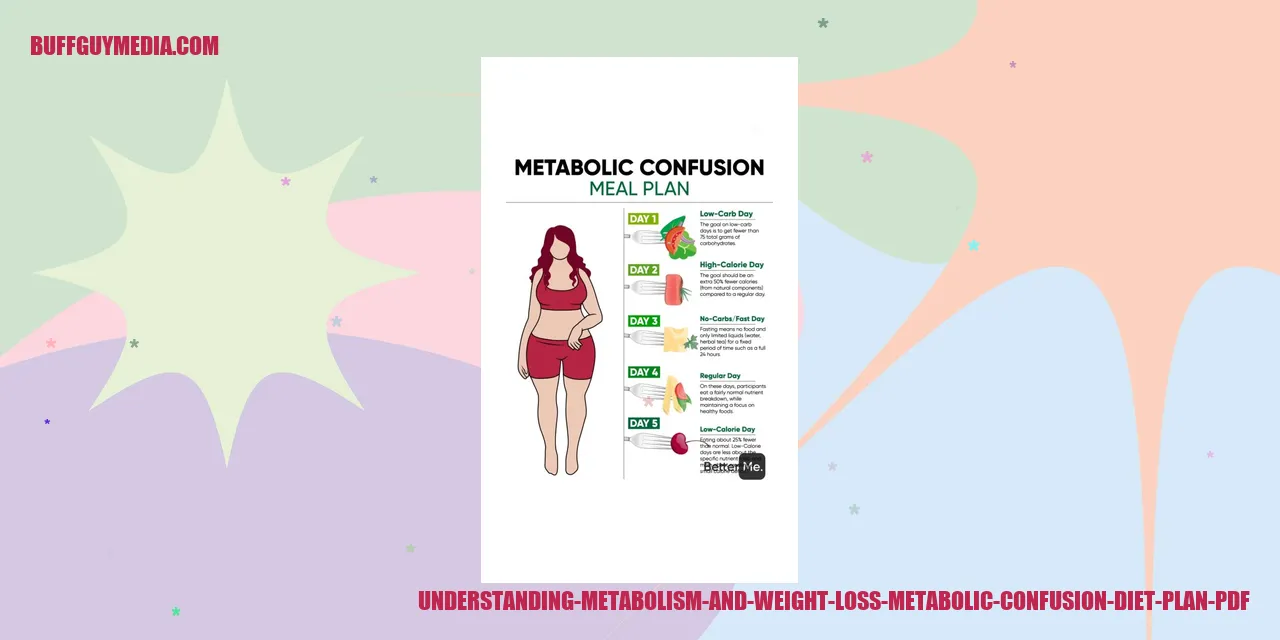
Unlocking the Secrets of Metabolism and Weight Loss
The Importance of Metabolism in Weight Loss
Understanding metabolism is key to achieving successful weight loss. Metabolism refers to the intricate process that takes place in our bodies to convert the food we consume into energy. It is responsible for the number of calories we burn daily, which directly affects our ability to lose weight.
Influential Factors on Metabolism
Several factors can have an impact on our metabolism. Age, gender, body composition, and genetics all play a role. As we grow older, our metabolism naturally slows down, making weight loss more challenging. Men generally have a higher metabolic rate due to a higher proportion of muscle to fat. Increasing muscle mass through strength training can boost your metabolism, as muscles require more energy to function than fat.
Tips for Enhancing Your Metabolism
Thankfully, there are effective strategies to rev up your metabolism and support your weight loss journey. Regular exercise, especially strength training exercises, can help build muscle and increase your metabolic rate. Including an adequate amount of protein in your diet can also aid in boosting metabolism, as the body expends more energy to digest protein compared to carbohydrates and fats. Proper hydration, sufficient sleep, and stress management are additional factors that can positively influence your metabolism.
The Metabolic Confusion Diet Plan: Your Secret Weapon
The Metabolic Confusion Diet Plan offers a systematic approach to optimizing your metabolism and achieving weight loss. This structured eating pattern involves alternating between different calorie levels and macronutrient ratios. By constantly challenging your metabolism through these variations, you can prevent it from adapting and slowing down. This proactive approach ensures that your metabolism remains active, promoting continuous weight loss and preventing frustrating plateaus.
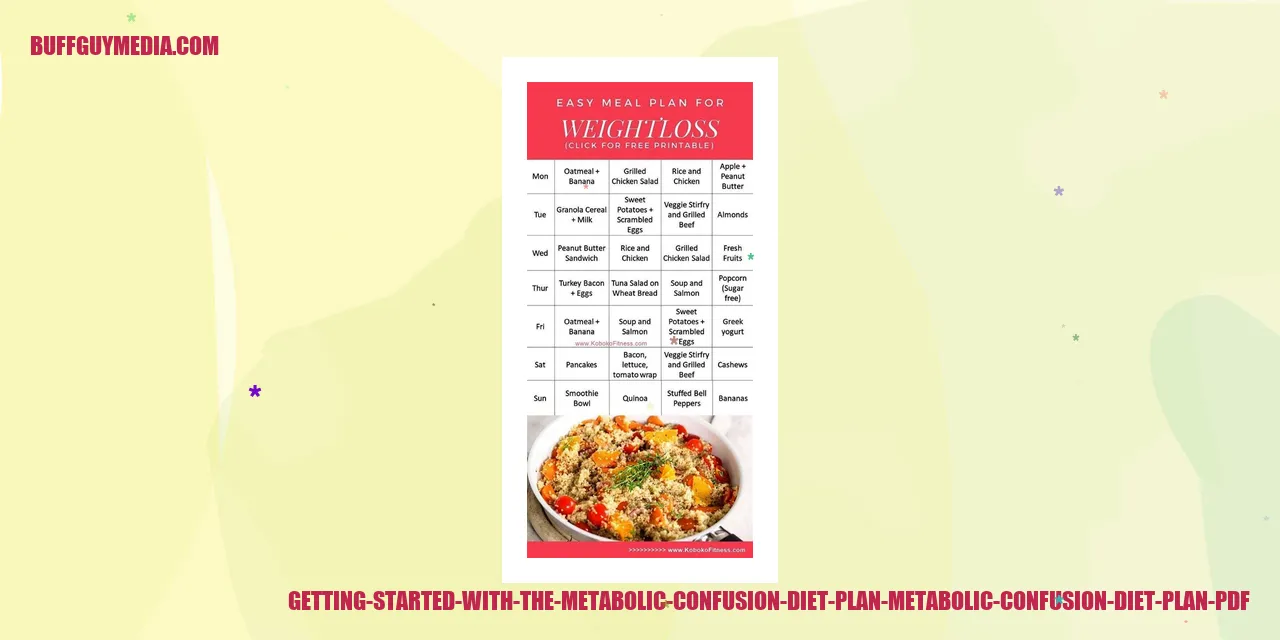
An Introduction to the Metabolic Confusion Diet Plan
Developing a Personalized Eating Strategy
As you embark on the Metabolic Confusion Diet Plan, it is essential to create a tailored eating strategy that aligns with your unique nutritional requirements and taste preferences. Taking into account your current dietary habits, you can identify suitable foods that conform to the diet plan’s principles and incorporate them into your meals. Consulting with a certified nutrition expert can greatly facilitate the creation of a well-rounded and effective meal plan that is tailored to your specific goals.
Realistic Goal Setting for Success
Prior to starting the Metabolic Confusion Diet Plan, it is of utmost importance to establish realistic goals that you can strive towards. Whether your objective is weight loss, improving energy levels, or enhancing overall health, having achievable targets will help keep you motivated and on track. Consider factors such as your current weight, lifestyle, and medical history when formulating your goals.
Preparation Tips for a Smooth Transition
Preparing to embark on the Metabolic Confusion Diet Plan involves making some adjustments to your daily routine. Begin by clearing out your pantry and refrigerator of processed, unhealthy foods, replacing them with fresh produce, lean proteins, and whole grains. Additionally, plan your meals in advance to ensure you have all the necessary ingredients readily available. By taking these steps, you will be well-prepared to commit to the diet plan without feeling overwhelmed or tempted to deviate from your course.
Tracking Progress and Making Adaptations Along the Journey
While following the Metabolic Confusion Diet Plan, it is essential to regularly track your progress. Maintain a food journal to record your daily intake and assess how different foods affect your well-being. Continuously monitor your weight, body measurements, and energy levels to evaluate the effectiveness of the diet plan. If necessary, make adjustments to your eating strategy and exercise routine to ensure continual progress towards your goals.
By adhering to these recommendations and customizing the Metabolic Confusion Diet Plan to suit your individual needs, you can embark on a transformative journey towards improved health and overall well-being. Remember, consistency and determination are crucial for achieving long-lasting results.

The Impact of Exercise on the Metabolic Confusion Diet Plan
The Significance of Exercise in Weight Loss
Exercise plays a vital role in shedding pounds, and this holds true for the Metabolic Confusion Diet Plan as well. Engaging in regular physical activity not only burns calories but also contributes to creating the necessary calorie deficit for effective weight loss. Additionally, exercise helps maintain muscle mass and boosts metabolism, thereby enhancing the efficiency of the weight loss process.
Recommended Types of Exercise for the Diet Plan
When following the Metabolic Confusion Diet Plan, incorporating various types of exercises can yield significant benefits. Cardiovascular activities like jogging, biking, or swimming help burn calories and enhance cardiovascular health. Incorporating strength training exercises, such as weightlifting or resistance band workouts, is also crucial for building and preserving muscle mass. A combination of cardio and strength training exercises ensures a comprehensive workout routine.
Tips for Integrating Physical Activity into Your Everyday Routine
Including physical activity in your daily life can be challenging, but it is essential for successful weight loss on the Metabolic Confusion Diet Plan. Here are some tips to help you incorporate exercise into your day effectively:
1. Schedule exercise: Dedicate specific time slots each day solely for exercise, demonstrating its significance.
2. Choose enjoyable activities: Engage in exercises that you genuinely enjoy, which will increase your adherence to the routine.
3. Start gradually: Begin with short exercise sessions and gradually ramp up the duration and intensity over time.
4. Stay active throughout the day: Look for opportunities to incorporate physical activity into your daily tasks, such as taking the stairs instead of the elevator or walking short distances instead of driving.
The Impact of Exercise on the Metabolic Confusion Diet Plan
Exercise complements the Metabolic Confusion Diet Plan by expediting weight loss and promoting overall well-being. Besides the calorie-burning aspect, exercise helps regulate blood sugar levels, lower blood pressure, enhance mood, and boost energy levels. By including exercise in your daily routine, you optimize the metabolic effects of the diet plan, paving the way for a more efficient path to achieving your weight loss goals.
Remember to consult healthcare professionals or certified fitness instructors before commencing any exercise program, particularly if you have underlying health conditions.
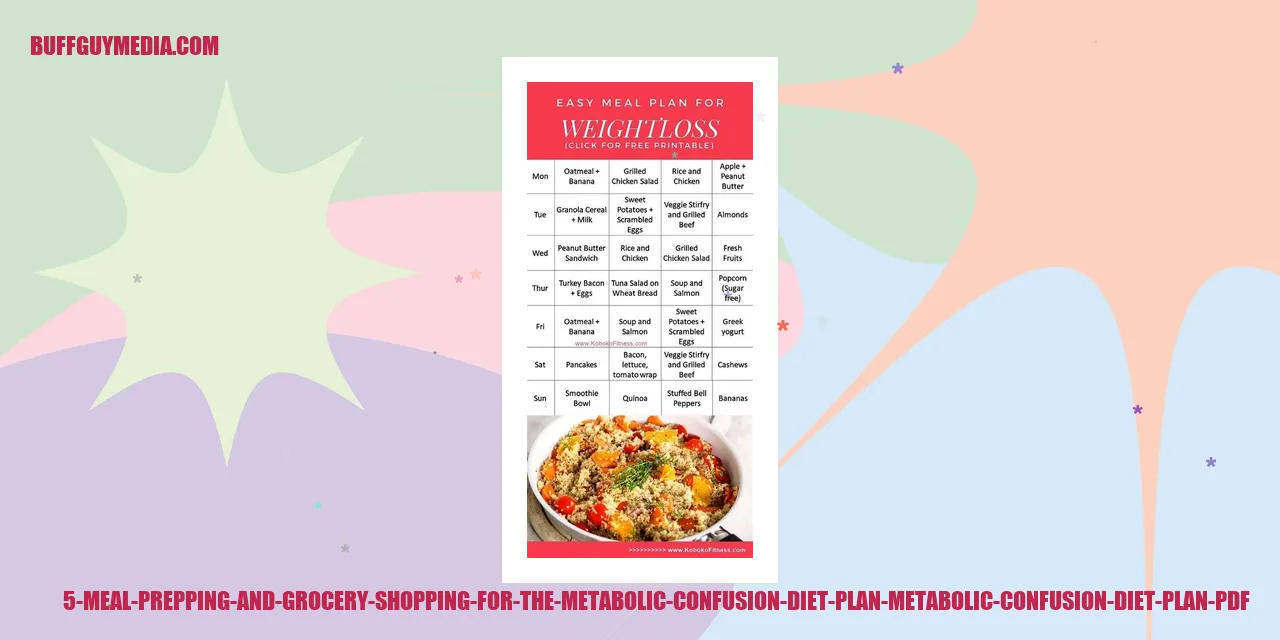
Meal Prepping and Grocery Shopping for the Metabolic Confusion Diet Plan
The Advantages of Meal Prepping
Meal prepping is a widely embraced method among individuals following the Metabolic Confusion Diet Plan. This approach involves preparing meals in advance, usually for a whole week, and storing them in the fridge or freezer. There are numerous benefits associated with meal prepping, including:
- Time-saving: By dedicating a specific time each week to meal prepping, you can significantly reduce the time spent on cooking and meal preparation on a daily basis.
- Assists in portion control: By pre-portioning your meals, you can ensure that you consume the appropriate amount of food, which is crucial for the success of the Metabolic Confusion Diet Plan.
- Reduces food wastage: Through meal prepping, you can plan your meals ahead, which minimizes the likelihood of purchasing excessive ingredients that may go to waste.
- Promotes healthier eating habits: When you have nutritious meals readily available, you’re less likely to give in to unhealthy food cravings or make impulsive food choices.
- Cost-effective: By purchasing ingredients in bulk and planning your meals in advance, you can save money in the long run.
Tips for Effective Meal Prepping
Meal prepping can seem overwhelming, especially if you are new to it. Here are some tips to help you excel:
- Prioritize meal planning: Dedicate time each week to plan your meals, including breakfast, lunch, dinner, and snacks. This ensures a well-balanced and varied diet.
- Invest in quality storage containers: Choose containers suitable for freezing, microwave-safe, and leak-proof to maintain the freshness of your meals and prevent any spills.
- Maximize freezer utilization: If you plan to prepare meals for an entire week, freezing some of them can help preserve their freshness.
- Label containers: To avoid confusion, label your containers with the date and the meal contents.
- Keep it simple: Begin with simple recipes and gradually experiment with more complex dishes. This approach helps you stay motivated and prevents feeling overwhelmed.
Creating a Grocery List for the Diet Plan
When it comes to grocery shopping for the Metabolic Confusion Diet Plan, it is crucial to focus on selecting healthy and nutrient-rich foods. Consider including the following items in your shopping list:
- Fresh fruits and vegetables: Aim for a variety of colorful produce to ensure you obtain a wide range of essential nutrients.
- Lean proteins: Opt for lean meats such as chicken breast, turkey, and fish, as well as plant-based protein sources like tofu and beans.
- Whole grains: Include whole grain products such as brown rice, quinoa, oats, and whole wheat bread.
- Healthy fats: Choose sources of healthy fats like avocados, nuts, seeds, and olive oil.
- Dairy or dairy alternatives: Select low-fat dairy products or alternatives such as almond milk or Greek yogurt.
Healthy Food Choices to Add to Your Shopping List
When finalizing specific food items for your shopping list, consider these healthy options:
- Crunchy Apples
- Nutrient-packed Spinach
- Nourishing Salmon
- Wholesome Quinoa
- Protein-rich Almonds
- Plain Greek yogurt with Live Cultures
- Skinless Chicken Breast
- Nutrient-dense Eggs
- Green and Fiber-rich Broccoli
- Heart-healthy Olive oil
By prioritizing these healthy choices, you will be on the right track to success with the Metabolic Confusion Diet Plan.

Defeating Obstacles and Sustaining Motivation on the Metabolic Confusion Diet Plan
Encountering Common Hurdles When Following the Diet Program
Embarking on the Metabolic Confusion Diet Plan can present various obstacles that need to be acknowledged and tackled in order to achieve success.
One typical hurdle faced by individuals is handling cravings for unhealthy food. As one transitions to a new diet plan, it is natural to experience desires for comfort foods or processed snacks. Another challenge can involve finding satisfying meal options that cater to dietary restrictions or preferences. Additionally, consistent meal planning and preparation can also pose a challenge for some individuals.
Recognizing these potential challenges is the first step towards overcoming them.
Strategies for Overcoming Obstacles
1. Maintaining Commitment: Develop a determined mindset and continually remind yourself of the reasons behind starting the Metabolic Confusion Diet Plan. This approach will help sustain motivation throughout the journey.
2. Planning in Advance: Set aside time to plan your meals ahead of time. This will ensure that you have nutritious options readily available and minimize the likelihood of making unhealthy food choices.
3. Seeking Support: Join a community or find an accountability partner who is also following the same diet plan. This way, you can share challenges, seek advice, and celebrate successes together.
4. Opting for Healthier Alternatives: When cravings strike, try to find healthier options that satisfy your taste buds. Look for recipes or pre-packaged snacks that align with the Metabolic Confusion Diet Plan.
5. Practicing Self-discipline: Avoid succumbing to temptations and instead, focus on long-term goals. Remember that staying committed to the diet plan will ultimately lead to better health and desired results.
Sustaining Motivation and Commitment to the Diet Plan
Staying motivated can be challenging at times, but there are strategies that can help maintain your commitment to the Metabolic Confusion Diet Plan.
1. Setting Attainable Goals: Break down long-term goals into smaller, manageable milestones. Celebrate each achievement, regardless of its size, to keep motivation high throughout the journey.
2. Tracking Progress: Regularly monitor progress by keeping a food diary, measuring body weight and inches, or using a fitness app. Seeing tangible results can significantly boost motivation.
3. Finding Inspiration: Seek out success stories of individuals who have achieved their goals on the Metabolic Confusion Diet Plan. Their journeys can serve as a source of inspiration and motivation for your own.
Celebrating Achievements and Rewarding Yourself Along the Journey
Recognizing and celebrating accomplishments throughout the journey is crucial to maintaining motivation and commitment to the Metabolic Confusion Diet Plan. Consider the following ways to reward yourself:
1. Non-food Rewards: Instead of indulging in unhealthy treats, treat yourself to something non-food related. This could include purchasing a new workout outfit, enjoying a spa day, or receiving a massage.
2. Sharing Success: Share your progress with loved ones or on social media. The positive feedback and encouragement you receive will further solidify your commitment and motivation.
3. Planning Cheat Meals: Occasionally indulge in a well-deserved cheat meal or treat. This provides a break from your routine and gives you something to look forward to.
4. Reflecting on Achievements: Take time to reflect on your accomplishments and acknowledge the hard work put into following the diet plan. Celebrate your determination and resilience.
By implementing these strategies, you can overcome challenges, sustain motivation, and celebrate successes while following the Metabolic Confusion Diet Plan.
Adjusting the Metabolic Confusion Diet Plan to Accommodate Dietary Restrictions

Catering the Diet Plan for Vegetarians/Vegans
Following the Metabolic Confusion Diet Plan can pose some challenges for individuals who adhere to a vegetarian or vegan lifestyle. However, by making a few adjustments, it is possible to tailor the diet plan to suit their dietary preferences while still achieving their weight loss objectives.
1. Protein Sources: Instead of relying on animal products like chicken and fish for protein, vegetarians/vegans can opt for plant-based alternatives such as tofu, tempeh, legumes, and lentils. These options provide adequate protein intake without compromising their meat-free diet.
2. Whole Grains: Vegetarians/vegans should incorporate whole grains into their meals to ensure sufficient fiber and nutrient intake. Excellent choices include quinoa, brown rice, whole wheat bread, and oats, which help maintain a balanced carbohydrate intake and supply sustained energy.
3. Healthy Fats: Avocados, nuts, seeds, and olive oil serve as great sources of healthy fats that can be included in the diet plan. These plant-based fats are essential for overall well-being.
Modifying the Diet Plan for Individuals with Gluten Intolerance
Individuals with gluten intolerance must make adjustments to avoid any discomfort or adverse reactions. Here’s how the diet plan can be modified:
1. Gluten-Free Grains: Substitute wheat-based products such as pasta, bread, and couscous with gluten-free alternatives like rice, quinoa, corn, or gluten-free oats. It’s crucial to read labels and choose certified gluten-free products.
2. Beware of Hidden Gluten: Many processed foods contain hidden gluten, so it’s important to carefully read ingredient labels. Opt for gluten-free versions or prepare homemade alternatives to avoid sauces, soups, and condiments that may contain gluten.
3. Explore Gluten-Free Recipes: There are numerous delicious gluten-free recipes available online. Experiment with dishes that include gluten-free grains, vegetables, lean proteins, and healthy fats to keep the diet plan diversified and enjoyable.
Adapting the Diet Plan for Individuals with Lactose Intolerance
Individuals with lactose intolerance may need to adapt the diet plan to prevent any digestive discomfort resulting from lactose-containing foods. Here are some helpful modifications:
1. Non-Dairy Alternatives: Substitute dairy products like milk, cheese, and yogurt with lactose-free options such as almond milk, soy milk, coconut milk, or lactose-free dairy products. These alternatives offer similar nutritional benefits without the lactose content.
2. Calcium-Rich Foods: Adequate calcium intake is crucial for maintaining bone health. Include calcium-rich foods such as leafy greens, fortified non-dairy milk, tofu, and almonds to compensate for the reduced dairy consumption.
3. Read Labels Carefully: Many processed foods may contain hidden lactose, so it’s important to read labels and choose lactose-free or dairy-free options. Look out for ingredients like whey, casein, and milk solids, which indicate the presence of lactose.
Substituting Ingredients for Allergies or Specific Dietary Needs
Individuals with allergies or specific dietary needs can still follow the Metabolic Confusion Diet Plan by substituting ingredients with suitable alternatives. Consider the following suggestions:
1. Nut Allergies: For those with nut allergies, replace nuts in recipes with seeds, roasted chickpeas, or dried fruits to add texture and flavor.
2. Egg Allergies: Use mashed bananas, applesauce, or flaxseed meal mixed with water as egg substitutes in baking recipes.
3. Gluten-Free and Vegan: For individuals with both gluten and dairy restrictions, opt for gluten-free grains and vegan protein sources such as tofu, tempeh, and legumes. Combine these with a variety of vegetables to ensure a balanced nutritional intake.
It’s essential to seek guidance from healthcare professionals or registered dietitians to personalize the diet plan according to individual dietary restrictions or needs. They can provide expert advice and ensure the diet plan remains nutritionally balanced while addressing specific requirements.

Effective Strategies for Sustaining Weight Loss and Transitioning from the Metabolic Confusion Eating Plan
Expert Tips to Maintain Weight Loss after Completing the Diet Plan
Completing the Metabolic Confusion Diet Plan is a notable achievement, but ensuring lasting weight loss success requires the adoption of specific habits. Firstly, continue following a well-balanced diet that includes a diverse range of nutrient-dense foods. Be sure to incorporate whole grains, lean sources of protein, and plenty of fruits and vegetables while moderating portion sizes. Continuing with regular physical activity is equally crucial. Discover enjoyable exercises and make them a regular part of your daily routine. Lastly, tracking your progress and recognizing small accomplishments can provide motivation along your weight loss journey.
Gradually Transitioning from the Diet Plan to a Sustainable Eating Pattern
A gradual and strategic transition is vital when moving away from the Metabolic Confusion Diet Plan. Abruptly reverting to previous eating habits can lead to weight regain. Instead, focus on incorporating new, healthy habits into your daily routine. Begin by slowly and steadily introducing additional calories into your diet, rather than drastically increasing your food intake. This gradual transition allows your body to adjust and helps maintain your hard-earned weight loss more effectively. Additionally, integrating whole foods, such as whole grains, lean sources of protein, and healthful fats, can ensure a smooth and sustainable shift towards a nourishing eating pattern.
The Importance of Consistent Mindful Eating Practices
Maintaining mindful eating habits is crucial for long-term weight management. Mindful eating involves being attentive to your body’s hunger and fullness cues, eating slowly, and savoring each bite. It helps establish a healthier relationship with food by fostering awareness of both emotional and physical hunger. Engage in mindful eating by listening closely to your body’s signals and selecting foods that nourish and satisfy you. This approach prevents overeating and supports weight maintenance once you have completed the diet plan.
Seeking Professional Guidance for Sustainable Weight Management
While completing the Metabolic Confusion Diet Plan is certainly an accomplishment, seeking professional guidance is essential for long-term weight management. Consulting a registered dietitian or nutritionist can offer personalized advice and support tailored to your specific needs. These experts can assist in developing a sustainable eating pattern, creating a realistic exercise plan, and addressing any unique challenges you may encounter. They also help identify potential triggers or barriers to weight loss maintenance, ensuring you achieve your long-term weight management goals successfully.
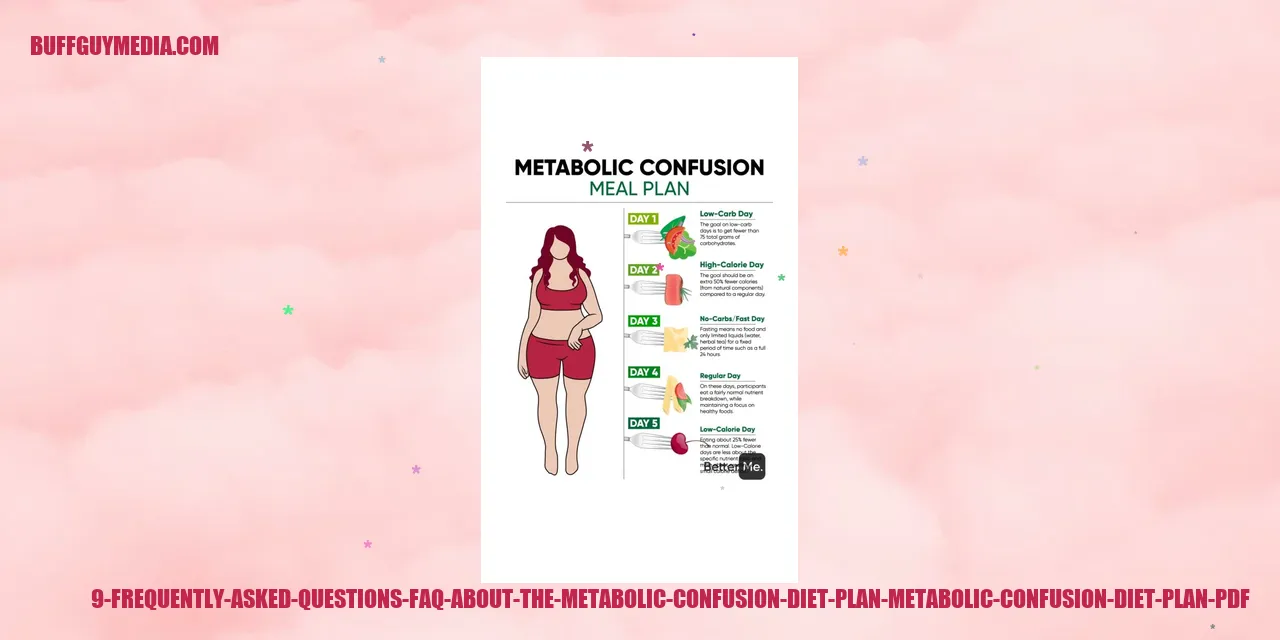
Frequently Asked Questions about the Metabolic Confusion Diet Plan
What are some prevalent side effects of this diet plan?
While adopting the Metabolic Confusion Diet Plan, individuals may experience occasional symptoms such as mild headaches, fatigue, or a sense of dizziness as their body adjusts to the dietary changes. These temporary side effects usually fade away within a few days.
Is the diet plan suitable for everyone?
The Metabolic Confusion Diet Plan is generally considered safe for most healthy individuals. However, it is essential to consult with a healthcare professional before embarking on any new diet or exercise regimen, particularly if you have any pre-existing medical conditions.
How long should I adhere to this diet plan?
The duration of following the Metabolic Confusion Diet Plan can vary depending on individual preferences and goals. Some individuals choose to follow the plan for a few weeks or even months, while others may adopt it as a long-term lifestyle change. It is crucial to listen to your body and make necessary adjustments as needed.
Can I consume alcohol while on this diet plan?
It is advisable to limit or avoid alcohol consumption while following the Metabolic Confusion Diet Plan as it can impede the plan’s effectiveness. Alcoholic beverages contribute empty calories and disrupt the body’s metabolic processes. For optimal results, it is best to minimize alcohol intake.
Are there any recommended supplements to take while following this diet plan?
Although the Metabolic Confusion Diet Plan prioritizes balanced and nutritious meals, certain individuals may benefit from incorporating specific supplements. It is recommended to consult with a healthcare professional or a registered dietitian to determine whether any particular supplements are necessary based on your individual needs.
What should I do if I am not seeing desired results with this diet plan?
If you are not achieving the desired results on the Metabolic Confusion Diet Plan, there are a few factors to consider. Firstly, double-check that you are correctly following the plan and accurately monitoring your food intake. If you are already doing so, it may be beneficial to consult with a healthcare professional or a registered dietitian to troubleshoot and make necessary adjustments.
Can I pursue this diet plan if I have a medical condition?
If you have a medical condition, it is crucial to consult with a healthcare professional before initiating any new diet plan. They can provide personalized advice and guidance based on your specific condition, ensuring your safety and overall well-being.


